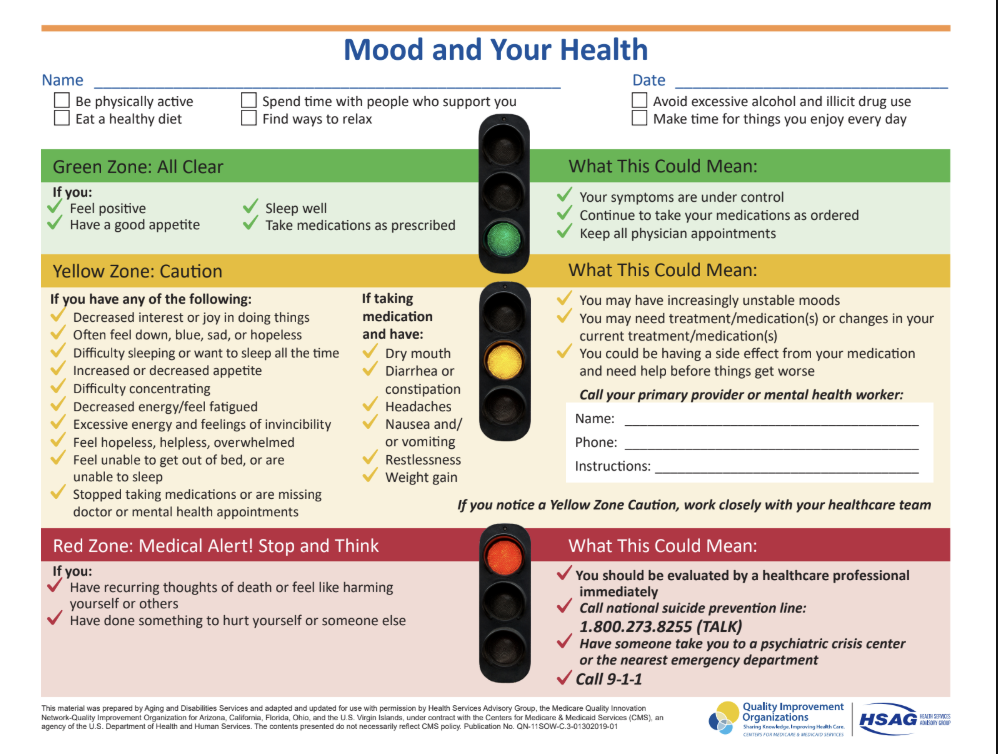📋 Instructional Guide for the Document
This document is a personal self-assessment tool designed to help you monitor and manage your mental and emotional health. It uses a simple, color-coded traffic light system (Green, Yellow, Red) to quickly identify when your symptoms are under control, when caution is needed, and when immediate medical help is required.
How to Use It:
- Fill Out the Top Section: Start by filling in your Name and the Date. Check all the healthy habits you are currently practicing.
- Review the Zones: Read the descriptions in the Green Zone, Yellow Zone, and Red Zone.
- Identify Your Current Zone: Check the symptoms listed under each color. You are in the zone that best describes your current feelings and behaviors.
- Green Zone: Indicates stability and control. Continue positive habits.
- Yellow Zone: Indicates a need for Caution. You should contact your mental health provider or primary care provider and follow the steps in the “What This Could Mean” column.
- Red Zone: Indicates a Medical Alert. Immediate professional intervention is necessary. Use the emergency resources provided.
- Track Changes: Use this sheet regularly (e.g., daily or weekly) to track changes in your mood. If you move from Green to Yellow, or if Yellow symptoms worsen, it’s a signal to act quickly and call your support team.

🎯 Purpose of the Document
The purpose of the “Mood and Your Health” tool is three-fold:
- Early Intervention: To provide a clear, objective checklist for recognizing subtle or escalating changes in mood and behavior before they become a crisis.
- Facilitate Communication: To give individuals and their support teams (family, friends, healthcare providers) a common language and framework for discussing mental health status.
- Promote Self-Management: To encourage individuals to take an active role in managing their condition by following prescribed maintenance steps (Green Zone) and seeking help promptly (Yellow Zone).
🧠 Mood and Your Health
| Field | Checkbox / Input |
| Name | |
| Date | |
| Healthy Habits | Be physically active Spend time with people who support you Avoid excessive alcohol and illicit drug use |
| Eat a healthy diet Find ways to relax Make time for things you enjoy every day |
Green Zone: All Clear
If you:
- Feel positive
- Have a good appetite
- Sleep well
- Take medications as prescribed
What This Could Mean:
- Your symptoms are under control
- Continue to take your medications as ordered
- Keep all physician appointments
🟡 Yellow Zone: Caution
If you have any of the following:
- Decreased interest or joy in doing things
- Often feel down, blue, sad, or hopeless
- Difficulty sleeping or want to sleep all the time
- Increased or decreased appetite
- Difficulty concentrating
- Decreased energy/feel fatigued
- Excessive energy and feelings of invincibility
- Feel hopeless, helpless, overwhelmed
- Feel unable to get out of bed, or are unable to sleep
- Stopped taking medications or are missing doctor or mental health appointments
If taking medication and have:
- Dry mouth
- Diarrhea or constipation
- Headaches
- Nausea and/or vomiting
- Restlessness
- Weight gain
What This Could Mean:
- You may have increasingly unstable moods
- You may need treatment/medication(s) or changes in your current treatment/medication(s)
- You could be having a side effect from your medication and need help before things get worse
- Call your primary provider or mental health worker:
- Name:
- Phone:
- Instructions:
If you notice a Yellow Zone Caution, work closely with your healthcare team
🔴 Red Zone: Medical Alert! Stop and Think
If you:
- Have recurring thoughts of death or feel like harming yourself or others
- Have done something to hurt yourself or someone else
What This Could Mean:
- You should be evaluated by a healthcare professional immediately
- Call national suicide prevention line: 1.800.273.8255 (TALK)
- Have someone take you to a psychiatric crisis center or the nearest emergency department
- Call 9-1-1
Source and Disclaimer
Source:
This material was prepared by Aging and Disabilities Services and adopted and updated for use with permission by Health Services Advisory Group (HSAG), which serves as a Medicare Quality Innovation Network-Quality Improvement Organization (QIN-QIO) for multiple states. The project was conducted under contract with the Centers for Medicare & Medicaid Services (CMS), an agency of the U.S. Department of Health and Human Services (HHS).
Disclaimer:
The contents presented in this document do not necessarily reflect CMS policy. It is intended as a self-management and educational tool and is not a substitute for professional medical diagnosis or treatment. Always consult with a qualified healthcare professional regarding any medical or mental health concerns. In case of a crisis (Red Zone), use the emergency resources listed immediately.
- 10 Essential Safety Tips for Working with Elders Experiencing Vision Loss
- Mood and Your Health: Tracking Your Emotional Well-being
- A Practical CBT Toolkit for Anxiety: How to Use These Worksheets Anytime You Need Them
- Coping Skills for Depression: A Simple, Do-Today Toolkit (Mindfulness + CBT Thought Record)
- Pain Management for Older Adults: A Friendly, Practical Guide for Families and Care Teams

